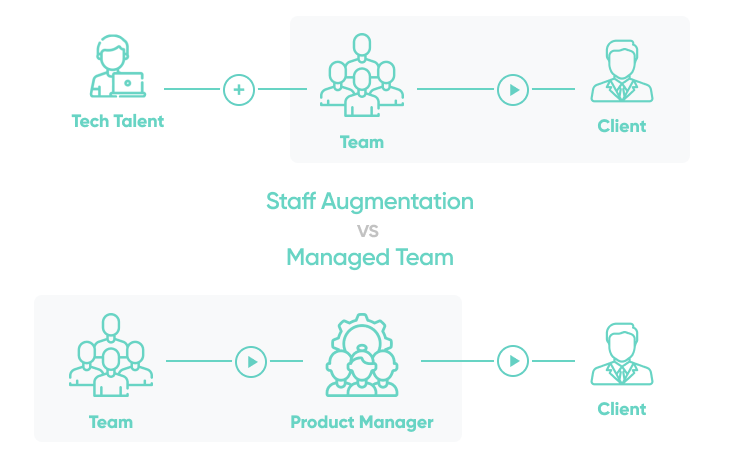IT projects outsourcing is often delivered as on-demand staff augmentation. In this model you are in charge and decide what to do, how, and when to do it. This requires that you have an existing leadership structure on your side.
When it comes to Managed Services, the part where you take over the whole process is far more limited. You can focus on your company operations and you can be sure that the IT services you need are handed off to the provider. It is the provider's responsibility that services are carried out in line with industry standards.
In this guide, we will go into detail to clarify the difference between staff augmentation and managed services. We will discuss the aspects when determining which option is best for your company.
What Is IT Staff Augmentation?
Staff augmentation is one of the Software Development Outsourcing Models. It involves hire additional tech talents and/or IT expertise by service provider. The main point is to support your team by supplement temporary lack of specialist or knowledge or maybe both, but without adding own staff (HR). Important in this case is to focus on providing input and effort without commitment to the results.

Benefits of Staff Augmentation Model
- Control and lower risk Staff Augmentation enables you to maintain complete control over the project's result and monitor every element of the process. The project manager for the team will prioritize work and ensure the final result is of high quality. When you outsource to a third-party supplier, you relinquish control over the development processes; however, with SA, you keep the whole team in-house and oversee the project, lowering the chance of delivering a substandard result.
- Flexibility You can rapidly acquire missing capabilities and skills and compensate for staff shortages caused by unanticipated occurrences during project execution. You have the last say on who you employ and for how long.
- Cost-effectiveness If you do not want to permanently hire additional staff, increasing the number of employees can save the cost of paying full-time wages. You receive the help of highly skilled experts for the precise amount of time that your team need it.
- Reduces the recruitment time In Staff Augmentation models, the procedure for hiring people falls on the service provider. Your task is to choose who you want to cooperate with.
- Adaptability Depending on the scale of your project, you may quickly acquire unique talents that are unlikely to be available locally or on short notice. Additionally, you may scale your team up or down as needed.
Drawbacks of Staff Augmentation Model
- Turn to long-term relation. Staff augmentation model can be challenged in long-term projects. Vendor workers may be required to take on additional tasks or leave the vendor.
- Cost effectiveness is challenged. In the long run, staff augmentation may cost you more in the long-term than a more permanent in-house solution. Of course this depends on your ability to hire and retain in-house talent.
- Dependence. Staff augmentation may lead to a greater reliance on a single third-party provider.
- Engagement scale. You may not be able to source enough talent from a single vendor. This will require you to work with different vendors and employees, which can create inconsistencies in quality.
When is Staff Augmentation effective?
There are cases when this model of outsourcing will work the best. The most important reasons are listed below.
Staff Augmentation works when:
- You need to reinforce your in-house team. While you have in-house software developers. For some new projects you will need current expertise. In this case you should strengthen your IT team.
- You are short on deadlines. The recruitment process takes a lot of time from job advertisement to onboarding. Staff augmentation model provides you the quick way to hiring extra developers independently of type of contract.
- You need specific skills. You need to quickly expand your team by bringing in skilled engineers or technicians.
- As a bridge for hire. Short-term employment may turn into longer employee relations.
What Is Managed IT Services?
Managed IT services entail outsourcing your business's management and support in order to improve operational efficiency. The managed service provider takes the position of a full-time staff member. These organizations have assembled a skilled team of specialists to relieve the technological lighten of a diverse customer base, allowing them to focus entirely on their core business and avoid the time-consuming effort of acquiring and retaining in-house workers.
Benefits of A Managed IT Services Model
- Time and expense savings. The managed services model enables you to engage a full team of competent and experienced experts equipped with the required technology and resources to work on your project. This manner, you save time, money, and effort by obtaining what you require. Their services are priced fixed and vary according to the quantity of work accomplished;
- Control Service provider oversees the project from start to finish. However, it is critical to select an experienced and reputable firm that has a track record of delivering high-quality goods and superior outcomes;
Monitoring The provider keeps an eye on all processes during the project and ensures that the required tools and resources are available;
The outcome of the project is determined by the vendor. MS organization assesses all risks and develops an appropriate plan for the project.
- Improved cost model Because managed IT service providers price based on outcomes, if your demand for a specific service increases or decreases, the price will adjust accordingly.
- Guaranteed result Managed IT services are supported by a service level agreement (SLA), which defines the scope and duration of each project. Managed service providers will make every effort to adhere to promises in order to get compensated and enhance the value of their job.
- Access to talents Because MSPs are frequently bigger than staff augmentation firms, they may provide a greater range of skills, knowledge, and solutions to address changing client demands.
Drawbacks of Managed IT Services Model
- Wrong service definition Defining illogical services/touch-points means complexity will increase. Outsourcing short-term initiatives may have more drawbacks than hiring additional staff.
- Over-specification Excessive specification of how a service should be performed frequently results in the service provider performing below optimally.
- Outsourcing the wrong processes Processes that require a high level of knowledge and are unique to the client organization may not be appropriate for managed services, or even outsourcing in general. Knowledge loss can result in provider lock-in.
- Wrong retained organization By allowing specialists to manage the service provider, you achieve "hands on, eyes off" rather than the reverse.
When is Managed Services Model Right for You?
- When you are focused on future growth As your company grows and more workers join your team, security and networking solutions get more complicated. Managed service providers can offer networking and security solutions that are both quicker and more efficient.
- To quickly adopt a new technology Managed service providers can execute client-centric solutions with careful technical preparation.
- When you need predictable budgeting IT cost is considered an investment by most companies. Managed services provide ongoing maintenance, which helps you avoid expensive surprises that may put a kink in your monthly budget.
- Your company must comply. Risks to your privacy and security may get you into severe trouble. By partnering with a managed service provider, you can ensure that you comply with laws such as HIPPA.
- When you want to build strong technical team Several distinct roles are required by your technical staff, and filling such roles internally may be expensive.
Difference between managed services and outsourcing
Both models can be used interchangeably. However, they differ from each other. Being aware of these differences will allow you to make the right decision and create the right model for your business.
In the outsourcing model, the customer and outsourcer must maintain close daily contact, since the customer retains the overall management of the project. When a client manages the main elements of the project with an in-house team and outsources certain secondary activities, the project begins with two parallel processes. The number of non-essential activities outsourced to a third-party supplier may, however, considerably surpass the volume of key processes. This model is typically used for some temporary projects.
Managed services model is often used when a client and a service provider want to establish a long-term relationship that extends beyond specific projects. Additionally, a managed service provider may get complete control of a project, as well as full accountability for the project's results.

IT Staff Augmentation vs. Managed Services: Comparison
Deciding which model will be best depends on your business, your mission statement and your focus. For the majority of businesses, the complexity of the information technology sector makes it impossible to stick to a single model. Even as companies grow more internationally competitive, adopting one model over another may not always be the best strategy. You can maximize the advantages of both staff augmentation and managed services by striking a balance between the two.
In general, the managed IT services model is the greatest option for forward-thinking businesses, particularly in terms of long-term cost savings and efficiency.
| Staff Augmentation | Managed Services | |
|---|---|---|
| Best for | Projects that require flexibility Short-term needs Low-budget projects | Outsourcing entire projects Long-term projects Costs savings over a period of time |
| Contribution | The service provider commits to providing defined resources at a price | The service provider assumes control of all or part of your IT service component |
| Billing | Billed based on time spent on the project, often biweekly | Billed on retainer, often annually |
| Processes | Committed to giving an input | Committed to delivering an outcome |
| Risk | Client | Service Provider |
| Engagement | Full time | Full time/Part-time |
| Does not provide service delivery commitments | Service delivery commitments are expressed as “service levels” | |
| Pricing | Pricing tied to availability and hours worked | Pricing tied to service levels and outcome |
| Management | Client | Service Provider |
IT Staff Augmentation with SoftKraft
With Team Augmentation, our team becomes an integral part of your team. We carefully select each team member based on the requirements and expertise you need. They immerse themselves in your project, maintaining your company culture and working in line with your strategic goals.
Engage quality tech professionals
We are driven by 15+ years of experience in IT staff augmentation and engineering software solutions.
Fast process: CVs within 3 days
Time and cost savings - receive first CVs of our specialists and start interviewing candidates.
Risk-free 2 weeks trial
To get rid of any doubts, check the quality of your team with no obligation to pay with 2-weeks trial.
Conclusion
Service providers have a role in every IT organization. But different problems require different solutions and different software outsourcing models.
With Managed Services, the vendor team operates independently of your in-house team. Outsourced Project Manager oversees daily operations and workflows. Managed IT services model is the best option when you want to handle project execution to a vendor. This works best with simple projects or repeated procedures.
If you're new to outsourcing, IT Staff Augmentation is a good and easy start. With staff augmentation, our team can immerse themselves in your project. This gives you more control, allowing for a more agile approach to scope and priorities.







